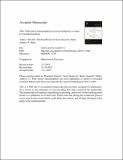Files in this item
Wild rufous hummingbirds use local landmarks to return to rewarded locations
Item metadata
| dc.contributor.author | Pritchard, David James | |
| dc.contributor.author | Scott, Renee D. | |
| dc.contributor.author | Healy, Susan Denise | |
| dc.contributor.author | Hurly, Andrew T. | |
| dc.date.accessioned | 2016-11-11T00:33:30Z | |
| dc.date.available | 2016-11-11T00:33:30Z | |
| dc.date.issued | 2016-01 | |
| dc.identifier | 229859955 | |
| dc.identifier | 52f30709-3644-4c50-94f6-6e56909bf483 | |
| dc.identifier | 84947798909 | |
| dc.identifier | 000368964300009 | |
| dc.identifier.citation | Pritchard , D J , Scott , R D , Healy , S D & Hurly , A T 2016 , ' Wild rufous hummingbirds use local landmarks to return to rewarded locations ' , Behavioural Processes , vol. 122 , pp. 59-66 . https://doi.org/10.1016/j.beproc.2015.11.004 | en |
| dc.identifier.issn | 0376-6357 | |
| dc.identifier.other | RIS: urn:02ECAF884F497F50DA079FA9AC5ED95C | |
| dc.identifier.other | ORCID: /0000-0002-8059-4480/work/60631314 | |
| dc.identifier.uri | https://hdl.handle.net/10023/9800 | |
| dc.description | This work was supported by the University of St Andrews, the University of Lethbridge and the Natural Sciences and Engineering Council of Canada. | en |
| dc.description.abstract | Animals may remember an important location with reference to one or more visual landmarks. In the laboratory, birds and mammals often preferentially use landmarks near a goal (“local landmarks”) to return to that location at a later date. Although we know very little about how animals in the wild use landmarks to remember locations, mammals in the wild appear to prefer to use distant landmarks to return to rewarded locations. To examine what cues wild birds use when returning to a goal, we trained free-living hummingbirds to search for a reward at a location that was specified by three nearby visual landmarks. Following training we expanded the landmark array to test the extent that the birds relied on the local landmarks to return to the reward. During the test the hummingbirds' search was best explained by the birds having used the experimental landmarks to remember the reward location. How the birds used the landmarks was not clear and seemed to change over the course of each test. These wild hummingbirds, then, can learn locations in reference to nearby visual landmarks. | |
| dc.format.extent | 521355 | |
| dc.language.iso | eng | |
| dc.relation.ispartof | Behavioural Processes | en |
| dc.subject | Spatial cognition | en |
| dc.subject | Navigation | en |
| dc.subject | Landmarks | en |
| dc.subject | Spatial learning | en |
| dc.subject | Hummingbirds | en |
| dc.subject | QH301 Biology | en |
| dc.subject | QL Zoology | en |
| dc.subject.lcc | QH301 | en |
| dc.subject.lcc | QL | en |
| dc.title | Wild rufous hummingbirds use local landmarks to return to rewarded locations | en |
| dc.type | Journal article | en |
| dc.contributor.institution | University of St Andrews. School of Biology | en |
| dc.contributor.institution | University of St Andrews. Institute of Behavioural and Neural Sciences | en |
| dc.contributor.institution | University of St Andrews. Centre for Social Learning & Cognitive Evolution | en |
| dc.contributor.institution | University of St Andrews. Centre for Biological Diversity | en |
| dc.identifier.doi | https://doi.org/10.1016/j.beproc.2015.11.004 | |
| dc.description.status | Peer reviewed | en |
| dc.date.embargoedUntil | 2016-11-10 |
This item appears in the following Collection(s)
Items in the St Andrews Research Repository are protected by copyright, with all rights reserved, unless otherwise indicated.

